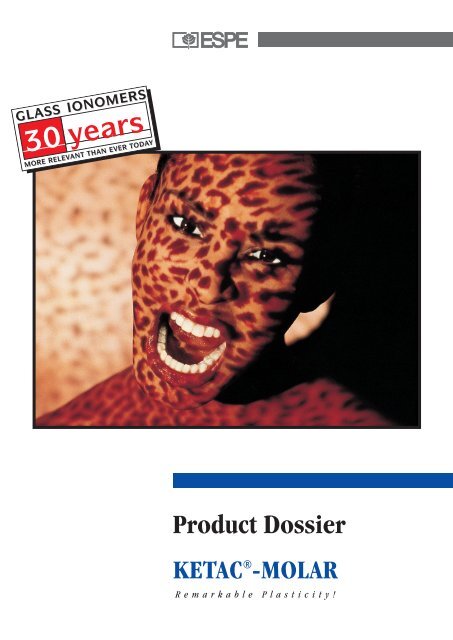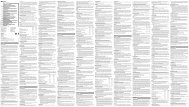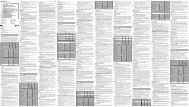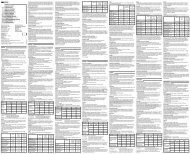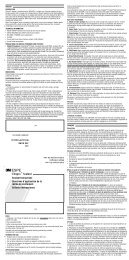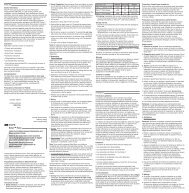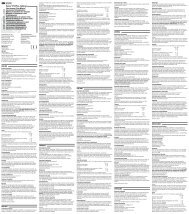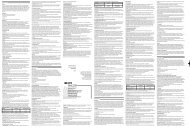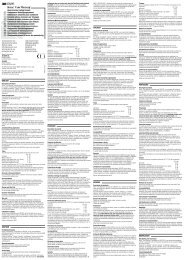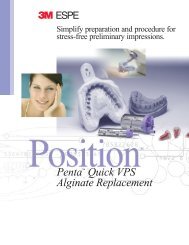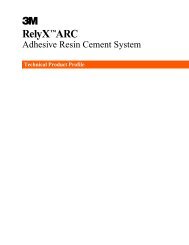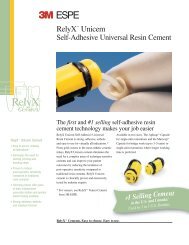3M ESPE Ketac-Molar
3M ESPE Ketac-Molar
3M ESPE Ketac-Molar
You also want an ePaper? Increase the reach of your titles
YUMPU automatically turns print PDFs into web optimized ePapers that Google loves.
Product Dossier<br />
KETAC ® -MOLAR<br />
Remarkable Plasticity!
Table of Contents<br />
1. Introduction 3<br />
1.1 History 3<br />
1.2 Indications 4<br />
2. Chemical Background 5<br />
3. Physico-technical Data 7<br />
4. Material-related Aspects 8<br />
4.1 Biocompatibility 8<br />
4.2 Fluoride Release 8<br />
4.3 Chemical Adhesion 9<br />
5. Competitors in Today’s Market 10<br />
6. Bibliography 13<br />
1
1. Introduction<br />
1.1 History<br />
Cements are material compounds in powdered form which are premixed with water or<br />
aqueous solutions.<br />
Breakdown of cements according to their main components:<br />
Powder<br />
Liquid<br />
ZnO<br />
Glass<br />
Phosphoric acid<br />
Phosphate cement<br />
Silicate cement<br />
Polyacrylic acid<br />
Carboxylate cement<br />
Glass ionomer cement<br />
When the two components are mixed, an acid-base reaction takes place which produces<br />
a salt gel that later sets as a more or less amorphous mass. Since some of the cement<br />
components are not affected by this reaction, a matrix will generally form which cements<br />
or cross-links the remaining metal oxide grains (e.g. in zinc phosphate cement).<br />
Cements have a variety of applications in the field of dental science. For example, they can<br />
be employed as definitive or temporary filling cements, as cavity lining material, as root<br />
fillers, or to attach metal restorations and orthodontic brackets.<br />
The dental cements available today are the result of an ongoing development since the<br />
middle of the 19th century. As early as 1856, Sorel produced a formulation for a magnesium<br />
chloride cement. The search for improved filling materials led to the development of<br />
numerous new types of cement, so that by the end of the 1920s the three basic cement<br />
types: zinc phosphate, zinc oxide eugenol and silicate, were firmly established in dental<br />
practice. Altough the scientific material properties of these substances improved dramatically<br />
over the following 50 years, the basic composition of these cements has remained<br />
the same.<br />
It was not until 1966 that D.C. Smith introduced a new cement type whose powder<br />
composition was essentially the same as that of zinc phosphate cements, but whose liquid<br />
component consisted of an aqueous polyacrylic acid. With this so-called carboxylate<br />
cement, Smith opened up a whole new field of adhesive fillers.<br />
In 1969, Wilson et al. successfully developed a novel glass ionomer cement from modified<br />
finely-ground silicate glass and polyacrylic acid. The first preparation was introduced three<br />
years later under the name of ASPA = Alumino-Silicate-Poly-Acrylate.<br />
The development of glass ionomers in the past 20 years has lead to many variations in<br />
powder components and polycarbonic acid. These differences in composition and the resulting<br />
variety of characteristics demonstrated by today’s glass ionomer cements make them<br />
particulary well-suited for the wide range of indications specific to this type of cement.<br />
3
KETAC-MOLAR represents the logical development of <strong>ESPE</strong> proven glass-ionomer<br />
filling material KETAC-FIL. It combines the advantages of glass ionomers with packing<br />
characteristics and flow properties that are novel for glass ionomer cements.<br />
1.2 Indications<br />
KETAC-MOLAR is a conventional, metal-free glass ionomer cement that has been specially<br />
designed as filling material for the lateral tooth area. Its improved mechanical properties,<br />
its packable consistency and greater radiopacity make it well-suited for linings under<br />
composite fillings of cavity classes I and II, for core build up under crowns, for primary-tooth<br />
fillings and for cavity class I restorations in non-occluded regions. Additional areas of<br />
indication include cavity class V fillings when aesthetic aspects do not play a major role,<br />
and temporary fillings for cavity classes I and II.<br />
Due to its wide range of indications, its quality criteria and its packable consistency<br />
KETAC-MOLAR can also be used as a temporary amalgam substitute.<br />
4
2. Chemical Background<br />
KETAC-MOLAR is, like all conventional glass ionomer cements, a powder/liquid system<br />
and is supplied both in hand-mixed and automatically mixed capsule systems (APLICAP).<br />
Unlike the capsule products KETAC-MOLAR APLICAP no polycarbonate acid is added to<br />
the powder in the hand-mixed version. The liquid in the hand-mixed version contains a correspondingly<br />
higher concentration of acid, however. For all versions in the KETAC-MOLAR<br />
range of products the same overall concentration of acid is obtained in the mixed state.<br />
In Table 1 the powder and liquid relationship and the percentage proportion of the acid<br />
components in powder and liquid are listed.<br />
Product<br />
Powder/liquid<br />
ratio<br />
Acid<br />
in powder<br />
Acid<br />
in liquid<br />
<strong>Ketac</strong>-<strong>Molar</strong> Aplicap 3,4 : 1 25 % 75 %<br />
<strong>Ketac</strong>-<strong>Molar</strong><br />
Hand-mixed version 3,0 : 1 0 % 100 %<br />
The powder/liquid ratio (by weitht) for the hand-mixed version lies between 3.0 and 1. This<br />
corresponds to a dosage of one spoonful of powder and to one drop of liquid.<br />
The powder used for the capsule preparations contains, alongside the ultrafine radiopaque<br />
aluminium-calcium-lanthanum-fluorisilicate glass, 5% spray dried <strong>ESPE</strong> polycarbonate acid<br />
(a copolymer from acrylic and maleic acid).<br />
This acidic to the powder leads to a greater overall acid concentration in the cement,<br />
resulting in increased cross-linkage and improved mechanical values without a dramatic<br />
increase in the initial viscosity. The cement’s liquid component, contained in capsule pillows,<br />
is an aqueous solution of polycarbonic acid and tartaric acid. The powder/liquid ratio is 3.5.1.<br />
KETAC-MOLAR is supplied in the well-known APLICAP capsule. However, because of the<br />
higher viscosity the application nozzle has been shortened, the cross section of the channel<br />
has been enlarged and the bending radius improved so that the cement can be pressed out<br />
more easily.<br />
When the powder and aqueous acidic solution are premixedy in universal mixing unit,<br />
e.g. <strong>ESPE</strong> ROTOMIX unit, carbonic acid COOH dissociates to COO (carboxylate ion) und H +<br />
(hydrogen ion). The positive H + ion attacks the surface of the glass, where primarily Ca 2+ ions<br />
are released along with a small number of Na + ions in the form of fluoride complexes.<br />
The liberated ions react with the acid and cross-link with the polyacrylic acid as calcium<br />
bridges to form a calcium polycarboxylate gel (Fig. 1) in which the non-reacted glass is<br />
embedded.<br />
5
Fig. 1: Polycarboxylate gel<br />
The continued attack of hydrogen ions cause a delayed release of AI 3+ ions from silicate<br />
glass in the form of AIF 2+ ions which are deposited in the already preformed matrix to form<br />
a water-insoluble Ca-Al-Carboxylate gel.<br />
Storing in water an extended period of time further stabilizes the cement’s microstructure<br />
(Fig. 2).<br />
Fig 2: The structure of a glass ionomer cement. The black areas represent non-reacted glass bodies<br />
which are encased in the gel matrix. This is formed as a result of the acidic attack and the subsequent<br />
release of AI 3+ and Ca 2+ ions from the glass.<br />
To achieve high strength properties and a packable consistency while maintaining good<br />
bonding characteristics, the grain distribution and the pretreatment of the glass have been<br />
specially optimized for KETAC-MOLAR.<br />
This means that 50% of the glass particles in KETAC-MOLAR are no greater than approx.<br />
2,8 µm in size, with 90% of the particles having a diameter of less than 9,6 µm.<br />
6
3. Physico-technical Data<br />
Because of the optimised glass particle size, KETAC-MOLAR has excellent mechanical<br />
properties. In Table 2 the material properties for the three KETAC-MOLAR products are<br />
compared, as measured using standardised methods:<br />
Curing time (min) ISO 9917 2:30<br />
KETAC-MOLAR<br />
APLICAP<br />
(average values)<br />
KETAC-MOLAR<br />
HAND-MIXED<br />
version<br />
3:30<br />
Compressive strength (MPa) ISO 9917<br />
Surface hardness (MPa) DIN 53456<br />
Radiopacity (%) ISO 4049<br />
Flexural strength (MPa) ISO 4049<br />
230<br />
460<br />
260<br />
33<br />
210±13<br />
420±82<br />
250<br />
37±6<br />
7
4. Material-related aspects<br />
4.1 Biocompatibility<br />
Dental materials should not be used intra-orally until the anticipated biological reaction<br />
processes have been clearly documented by histological studies conducted under application<br />
conditions and the materials have been classified as being safe to use. A large<br />
number of publications have certified that the pulpa compabitility of glass ionomer cements<br />
is satisfactory to good, yet just as many doubts have also been expressed, particularly after<br />
cell culture tests.<br />
The polyacrylic acids present in glass ionomer cements are relatively weak acids. However,<br />
the degree of acidity and the duration of acid release are highly dependent on the powder/<br />
liquid ratio. The high viscosity of KETAC-MOLAR is achieved by its high powder factor and<br />
thus only a low level of acid release can be expected. In addition, the administered form<br />
in capsule preparations allows for exact dosing and thus a constant acid ratio.<br />
4.2 Fluoride release<br />
The powder component of glass ionomer cements contains crystalized ingredients rich in<br />
calcium fluoride. After the powder and liquid have been premixed and the acid/base<br />
reaction initiated, the negative fluoride ions are released from the powder along with the<br />
positive Ca 2+ ,AI 3+ and Na + ions and build up in the cement matrix as ions, salt compounds<br />
or complex compounds. Most of the fluoride released from the set cement is delivered by<br />
these compounds.<br />
Glass ionomer cements exhibit a high degree of initial fluoride discharge, since most of the<br />
fluoride released is stored in the surface of the filling. The rate of fluoride release continues<br />
to decline over several month and then stabilizes at a constant level. The liberated fluoride<br />
proceeds from the interior of the filling to its surface, where it then goes into solution. The<br />
use of tooth-paste, gels or solutions containing fluoride can enhance the refluoridization of<br />
glass ionomer cements fillings.<br />
KETAC-MOLAR releases on the whole less fluoride than other glass ionomer cements<br />
because its solubility is less than that of comparable cements. Test samples of<br />
KETAC-MOLAR, which were placed in water 1 hour later exhibit a total solubility of<br />
0.05% after 24 hours (KETAC-FIL 0,2%). When the samples were placed in water after<br />
only 10 minutes (“10-minute solubility”), solubility values of 0.18 – 0.26% (GIZ “H” 1.7%)<br />
were measured for KETAC-MOLAR.<br />
Since glass ionomer cements release considerably greater amounts of fluoride than silicate<br />
cements, compomers or even composites, their use is particularly suited for treating<br />
children, adults with caries or the elderly.<br />
8
4.3 Chemical adhesion<br />
The adhesive bonding behaviour of filling materials makes it possible to form preparations<br />
that are gentle on tooth substance. However, the borders of a glass ionomer cement filling<br />
must achieve a thickness of at least 0.5 mm in order to avoid any breaking off of the filling’s<br />
borders. The chemical adhesion of a cement to the hard dentine substance was already<br />
shown by the carboxylate cements, whose polyacrylic acids form a chelate bond with the<br />
calcium ions hard dentine substances (enamel and dentine).<br />
The initial bonding process probably arises through the formation of hydrogen bridges<br />
between the carboxyl groups and the hydroxyl apatite of the hard dentine substances,<br />
although it is likely that the ionic bonds thus formed then predominate. Furthermore, an<br />
additional chemical bond is thought to exist with amino acids and the carbonic acids of<br />
dentine collagen. Due to the high percentage of hydroxyl apatite in the enamel, one must<br />
assume that the bonding forces to enamel are stronger than those to dentine.<br />
Although glass ionomer cements can also bond directly to enamel and dentine in the<br />
presence of a smear layer, its removal can increase adhesive bonding forces. For this reason<br />
pretreatment with KETAC CONDITIONER (a 25% polyacrylic acid solution) is recommended<br />
before applying KETAC-MOLAR.<br />
Conditioner<br />
Dentin adhesion [MPa] median<br />
25%/75% quantile [MPa]<br />
without Polyacrylic acid 1.2<br />
1.0/2.5<br />
10 sec Polyacrylic acid<br />
30 sec Polyacrylic acid<br />
60 sec Polyacrylic acid<br />
2.1<br />
3.2<br />
3.0<br />
1.1/3.3<br />
2.5/3.8<br />
2.5/4.3<br />
Fig 3: Dentine adhesion using KETAC-MOLAR APLICAP on noncarious human molars (shear test<br />
according to ISO TR No. 11405); Universität Regensburg, Dr. Friedl<br />
9
5. Competitors in today’s market<br />
Since current glass ionomer cements fail to achieve sufficient hardness and resistance to<br />
fracture and have a low abrasion resistance, many dental manufacturers have tried to create<br />
glass ionomer cements with improved mechanical properties by modifying their composition.<br />
By varying the powder/liquid ratio of the grain distribution and the polycarbonic acid balance<br />
in liquid and powder, greater strength properties and a packable consistency can be achieved<br />
while maintaining good setting properties.<br />
In a comparative study of abrasion resistance as measured by two-body abrasion tests under<br />
simulated intra-oral conditions, KETAC-MOLAR showed an abrasion resistance comparable<br />
to GIC “H” (Fig. 4).<br />
Abrasion in µm<br />
450<br />
400<br />
350<br />
300<br />
250<br />
200<br />
150<br />
100<br />
50<br />
0<br />
<strong>Ketac</strong>-<strong>Molar</strong> GIZ H. GIZ F. <strong>Ketac</strong>-Silver<br />
Fig. 4: Abrasion values of KETAC-MOLAR, GIC “H”, GIC “F9” and KETAC SILVER after 2,000 load<br />
cycles with a vertical force of 50 N using the pin-on-block method. Tests were conducted with<br />
cylinder-shaped AI 2 O 3 antagonists at the Munich mastication simulator.<br />
10
Three-body abrasions tests for simulating food abrasion on contectless surfaces show<br />
abrasion values for KETAC-MOLAR that are lower than the other tested materials (Fig. 5).<br />
Abrasion in µm<br />
80<br />
70<br />
60<br />
50<br />
40<br />
30<br />
20<br />
10<br />
0<br />
<strong>Ketac</strong>-<strong>Molar</strong> GIZ H. GIZ F. <strong>Ketac</strong>-Silver<br />
Fig. 5: Three-body abrasion values of KETAC-MOLAR, GIC “H”, GIC “F9” and KETAC SILVER after<br />
200,000 abrasion cycles in the ACTA-machine (Munich version). Tests were conducting using a<br />
millet suspension and 15 N application force.<br />
In terms of dentine adhesion, the adhesive strength of KETAC-MOLAR is comparable to that<br />
of GIC “H”, GIC “F9”, with KETAC-MOLAR und GIC “H” showing slightly better values when<br />
compared to GIC “F9” (Fig. 6).<br />
MPa<br />
1,6<br />
1,4<br />
1,2<br />
1,0<br />
0,8<br />
0,6<br />
0,4<br />
0,2<br />
0<br />
<strong>Ketac</strong>-<strong>Molar</strong> GIZ H. GIZ F.<br />
Fig. 6: Dentine adhesion using bovine dentine, in MPa (in-house data)<br />
11
A comparison of fluoride ion release data shows that KETAC-MOLAR exhibits considerably<br />
lower values than the other materials tested. This can be explained by the low solubility of<br />
KETAC-MOLAR in comparison with other glass ionomer cements referred to previously.<br />
However, this property does ensure good surface quality and a tight seal along the cavity<br />
border over a comparably longer period of time.<br />
ppm<br />
2,5<br />
2,0<br />
1,5<br />
<strong>Ketac</strong>-<strong>Molar</strong><br />
D-Compomer<br />
T-F(+)-C.<br />
Z-F(-)-C.<br />
1,0<br />
0,5<br />
0<br />
1. W. 2. W. 3. W. 4. W. 5. W. 6. W.<br />
Fig. 7: Fluoride release of KETAC-MOLAR, compomer “D”, the composite “T” containing fluoride,<br />
and the fluoride-free composite “Z”. The test bodies were placed in water 1 hour after setting.<br />
The fluoride levels of the chart were determined after 1 week of water storage.<br />
12
6. Bibliography<br />
A.S. Atkinson, G.J. Pearson<br />
“The evolution of glass-ionomer cements”, Br Dent J 159, 335-337 (1985)<br />
R. Beer<br />
“Glasionomerzemente – Biologisch unbedenkliche Füllungsmaterialien?”<br />
[Glass-ionomer cements – biologically safe filling materials?]<br />
Quintessenz 45, 1073-1088 (1994)<br />
E. Hellwig, J. Klimek, T. Attin<br />
“Einführung in die Zahnerhaltung”, [Introduction to tooth conservation]<br />
Urban and Schwarzenberg, Munich 1995<br />
R. Hickel<br />
“Einsatzgebiete und -verfahren von Glasionomerzement als Füllungsmaterial”,<br />
[Range of application and techniques for using glass-ionomer cement as a filling material]<br />
Zahnärztl. Mitt. 8, 914-919 (1989)<br />
P.R. Hunt<br />
“Glass Ionomers – The next Generation”,<br />
Internat. Symposia in Dentistry, Philadelphia 1994<br />
S. Katsuyama, T. Ishikawa B. Fujii<br />
“Glass Ionomer Dental Cement – The Materials and Their Clinical Use”.<br />
Ishiyaku Euro-America, Inc. 1993<br />
R.W. Phillips<br />
“Skinner’s – Science of Dental Materials”, W.B. Saunders Company, Philadelphia 1991<br />
J.A. Warren<br />
“Glass Ionomer – Its Emerging Role as an Intermediary Dental Base”.<br />
Florida Dental Journal, Vol. 57 (2), 1986.<br />
R. Guggenberger, R. May, K.P. Stefan<br />
“Developments in Glass Ionomer Chemistry”, 1 st Int. Symposium on GI 1996, U.K.<br />
H. Schuh<br />
“Glasionomerzemente, Teil 1 und Teil 2”, [Glass-ionomer cements, Part 1 and Part 2]<br />
special issue, Zahnarztmagazin 1/93<br />
N. Krämer, M. Pelka et al.<br />
“Abrasionsbeständigkeit von Kompomeren und stopfbaren Glasionomerzementen”,<br />
[Abrasion resistance of compomers and packable glass-ionomer cements]<br />
Universität Erlangen; lecture at DGZMK annual convention, Leipzig 1995<br />
13
756 432/01 (4.99)


